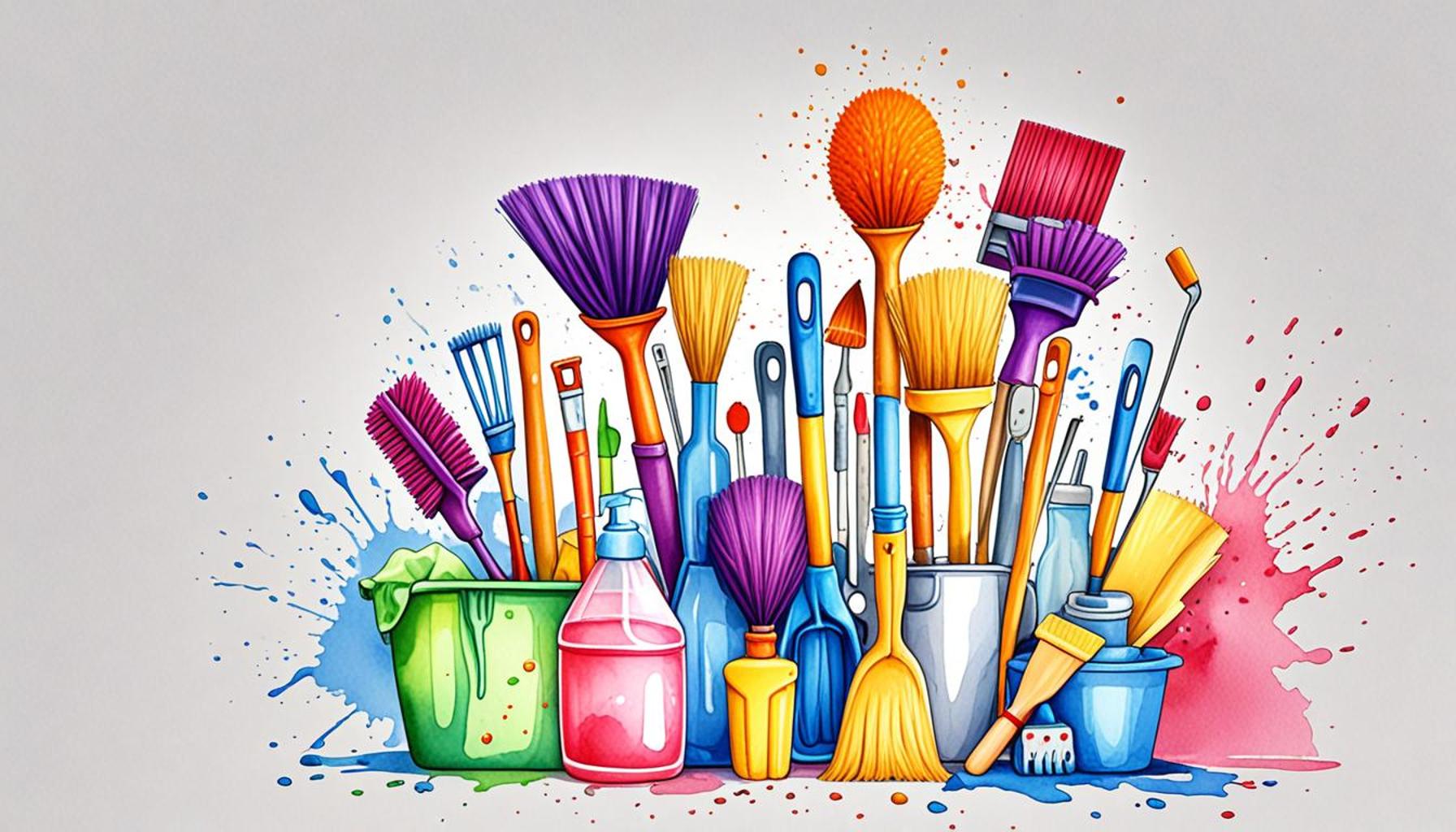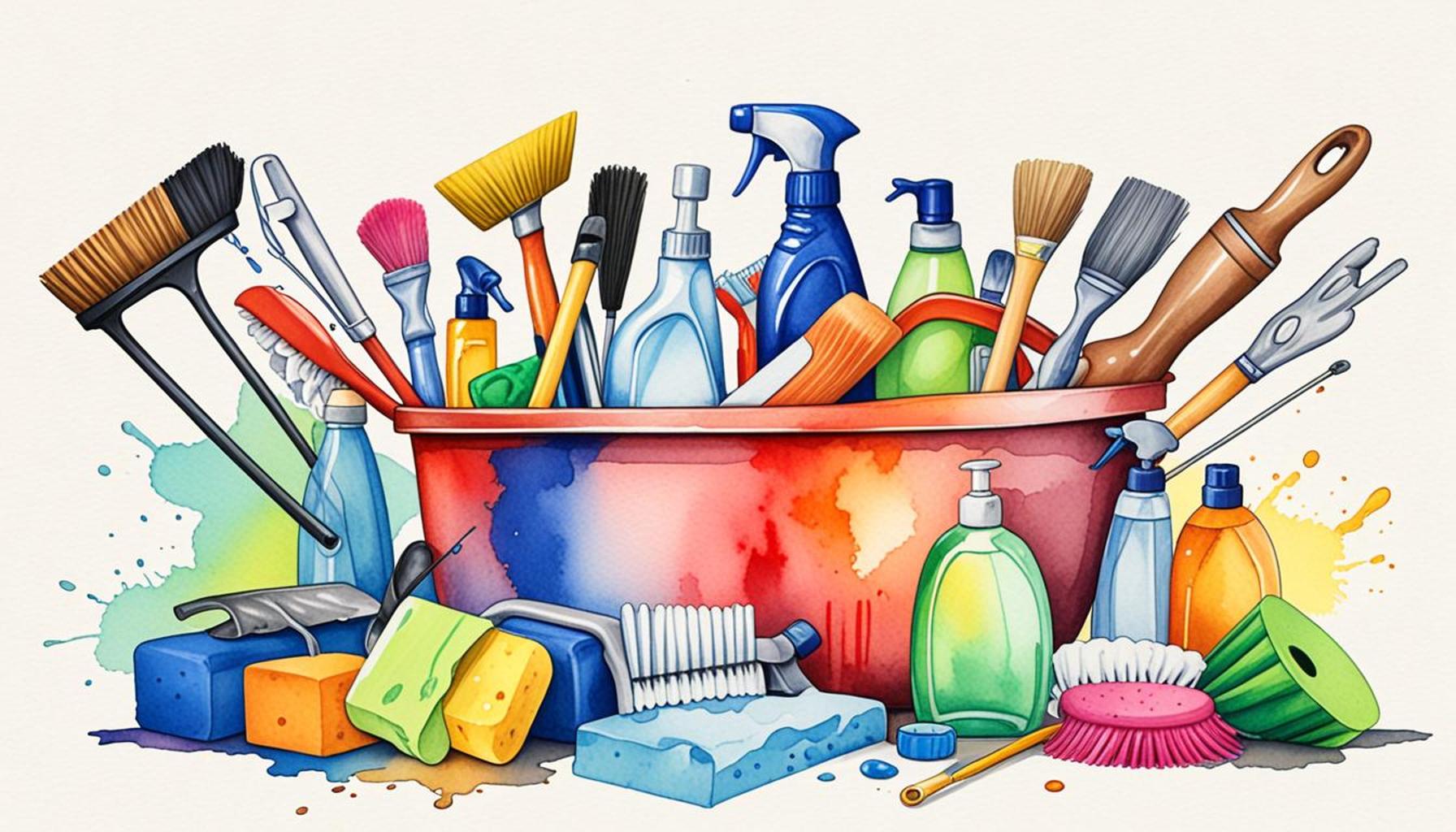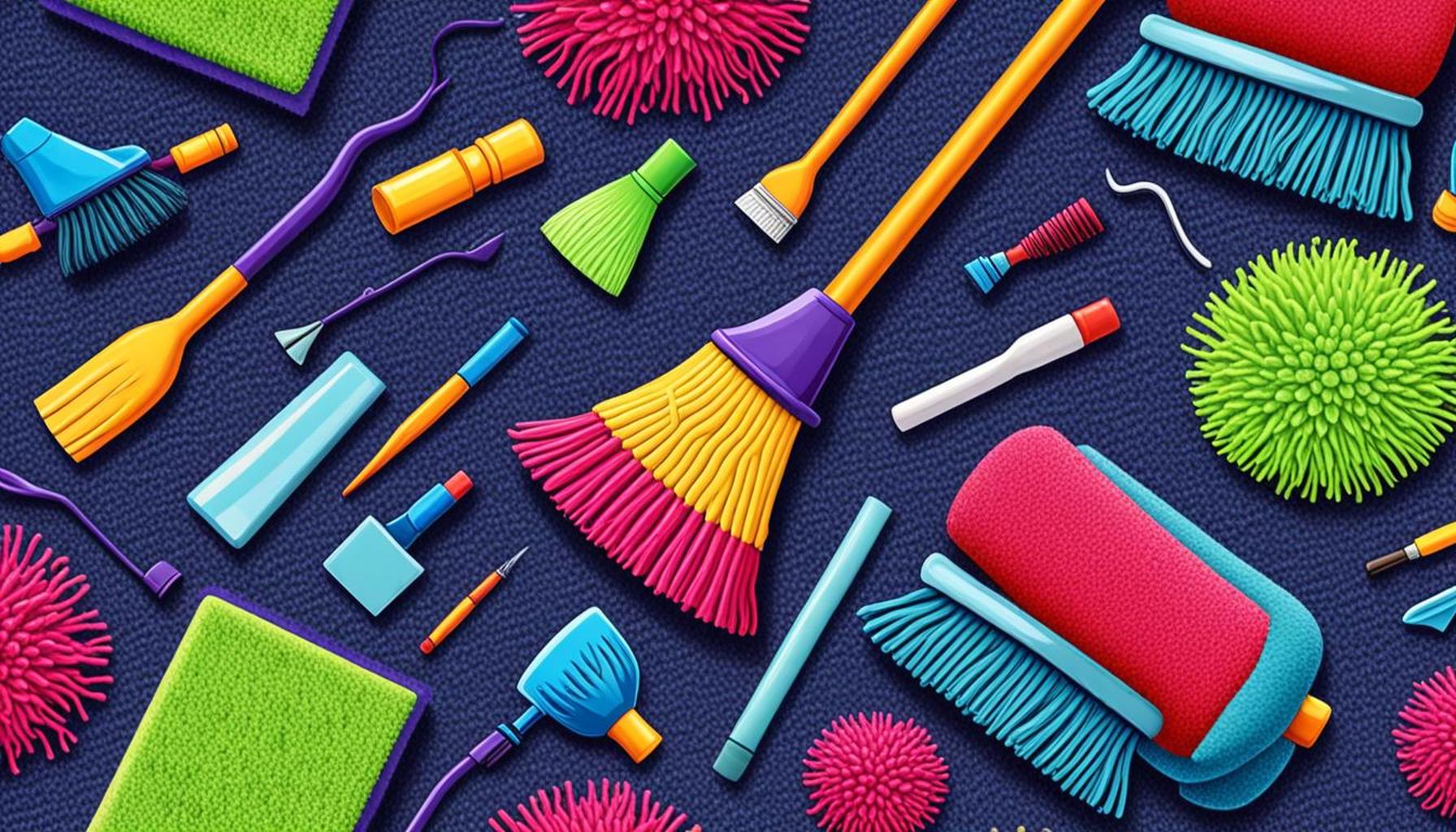Innovative Cleaning Tools: What’s New in the Market?

Revolutionizing Cleaning Practices
In recent years, the cleaning industry has experienced transformative changes driven by groundbreaking technology and a focus on sustainability. Innovative cleaning tools are redefining not only how we maintain our living and working environments, but also our relationship to cleanliness and the products we use. This shift has brought forth a new era where efficiency, convenience, and eco-friendliness coexist, making cleaning a less burdensome chore.
Smart Cleaning Gadgets
Among the most noticeable advancements are robotic vacuums. These autonomous devices have gained popularity for their ability to navigate homes using sophisticated sensors and mapping technology. Brands like iRobot’s Roomba and Neato have made name recognition by delivering consistent cleaning results with minimal user intervention. Users can now schedule their robotic vacuums to clean while they are away, allowing their vacuuming needs to be managed even amidst a busy lifestyle.
Furthermore, steam mops have emerged as a game-changing tool for floor cleaning. Using high-temperature steam, they sanitize surfaces without the need for chemical cleaners, making them an ideal option for households with children or pets. The reliability of steam, as well as its ability to remove tough dirt and grime, has made these mops a staple in many American homes.
Another noteworthy addition is the electric scrubbing brush, which boasts powerful motorized brushes designed for heavy-duty cleaning tasks. These tools effectively tackle surfaces like grout and ceramic tiles, making them particularly useful in kitchens and bathrooms where deep cleaning often feels labor-intensive. The ease of use combined with incredible cleaning power is attracting many consumers who previously found scrubbing by hand to be a tedious task.
Commitment to Sustainability
As the cleaning industry evolves, a significant focus has been placed on sustainability. Manufacturers are increasingly opting for biodegradable materials in their products, effectively reducing plastic waste and environmental impact. For instance, cleaning pads and brushes made from natural fibers are gaining traction as they break down more easily once disposed of.
Additionally, many new gadgets are designed with energy-efficient features, reducing electricity consumption without compromising performance. Products that utilize lower power settings while maintaining cleaning effectiveness are attractive to environmentally conscious consumers. For example, certain models of robotic vacuums are designed to optimize their cleaning routes to minimize energy usage.
Finally, the concept of multi-purpose functionality is reshaping how consumers view their cleaning tools. Products that combine multiple functions, such as vacuuming and mopping in one, not only save space but also reduce clutter in homes. This simplification of cleaning tools appeals especially to those in urban settings where space is often at a premium.
The adoption of these innovative tools signifies a major shift in cleaning practices, promising a cleaner home while promoting a more efficient and sustainable way of living. As consumers become more discerning about their choices, the demand for such products is likely to continue growing. Join us in exploring these exciting developments that are shaping the future of cleaning technology.
DIVE DEEPER: Click here to discover the science behind eco-friendly cleaning products
Emerging Trends in Cleaning Technology
As the demand for more efficient, effective, and environmentally friendly cleaning solutions rises, manufacturers are stepping up their game by introducing innovative cleaning tools that cater to modern lifestyles. These tools not only enhance productivity but also aim to simplify the often tedious process of cleaning. Here’s a closer look at some of the latest trends shaping the cleaning market.
The Rise of Cordless Technology
Cordless cleaning devices have transformed traditional cleaning paradigms, offering users enhanced mobility and convenience. Cordless vacuum cleaners, such as those from Dyson and Shark, allow for quick clean-ups without the hassle of tangled cords or finding a power outlet. These units are lightweight and often designed with powerful suction capabilities, making them perfect for both quick spills and thorough cleans. Additionally, cordless models generally come with a variety of attachments and brush heads, enabling users to tackle different surfaces and cleaning tasks more efficiently.
The growing trend of cordless stick vacuums is particularly appealing for urban dwellers in smaller apartments where space can be a constraint. These slim designs eliminate the need for bulky machines and cumbersome storage solutions, merging sleek aesthetics with high performance.
Advanced Filtration Systems
Another noteworthy development in cleaning tools is the integration of advanced filtration systems. For households with allergy sufferers or pet owners, vacuums equipped with HEPA (High-Efficiency Particulate Air) filters have become increasingly essential. These filters can effectively trap 99.97% of dust, pollen, and other airborne particles, ensuring cleaner air quality. Brands like Hoover and Bissell have made significant strides in marketing their models with these features, highlighting the health benefits of investing in quality filtration technology.
Moreover, air purifiers are emerging as popular cleaning companions, effectively improving indoor air quality by filtering pollutants and allergens. Standalone air purifiers and those integrated into vacuum systems provide an all-around cleaning experience, addressing both surfaces and the atmosphere within the home.
Versatile Cleaning Solutions
Consumers are increasingly gravitating toward multi-functional cleaning tools that offer more than one application. For instance, the new wave of 2-in-1 vacuum and mop systems is gaining traction, appealing particularly to those with limited storage space. These devices seamlessly switch between vacuuming dry debris and mopping up spills, streamlining the cleaning process to save time and effort.
Additionally, tools like high-powered pressure washers are gaining popularity not just for outdoor surfaces, but also for indoor use. Equipped with adjustable nozzles, these versatile machines can tackle everything from car detailing to outdoor furniture cleaning. With portability and efficiency at their forefront, these products are proving that innovation in cleaning tools is about versatility and adaptability, saving both time and resources.
Conclusion
The cleaning industry is witnessing incredible comprehensive advancements, seamlessly merging functionality with modern consumer needs. As we continue to explore innovative cleaning tools, it’s clear that the future of cleaning is not only about efficiency but also about creating a sustainable and convenient cleaning experience. Stay tuned as we delve deeper into more groundbreaking innovations redefining how we think about cleanliness.
Innovative Cleaning Tools: What’s New in the Market?
As we delve deeper into the myriad of innovative cleaning tools available today, it’s evident that technology and design advancements are profoundly transforming our cleaning routines. These new tools not only enhance efficiency but also incorporate sustainability and user-friendliness as key features. Here, we explore the exciting categories emerging in the cleaning tools market.
| Category | Key Features |
|---|---|
| Smart Vacuum Cleaners | Equipped with AI technology for efficient navigation and cleaning. |
| Eco-Friendly Cleaning Solutions | Biodegradable formulas that reduce environmental impact. |
The introduction of smart vacuum cleaners illustrates the fusion of intelligence with functionality. These devices use advanced sensors and mapping technology to effortlessly maneuver through homes, ensuring every corner is reached and cleaned with precision. They can be controlled via smartphones, allowing for scheduling and monitoring from anywhere. This revolutionary approach not only saves time but also maximizes cleaning efforts.
Another significant innovation lies in the eco-friendly cleaning solutions that are making waves in the market. As consumers become increasingly aware of their ecological footprint, the demand for sustainable cleaning products has surged. These solutions are formulated using natural ingredients that are safe for both users and the environment, providing effective cleaning without harmful chemicals. By embracing these products, you’re not just maintaining cleanliness; you’re contributing to a cleaner planet.
Both categories highlight the exciting changes in the cleaning tools sector, appealing to modern consumers who seek efficiency paired with responsibility. As we continue to witness improvements and innovations, the future of cleaning is looking not only cleaner but also smarter and more sustainable than ever before.
Dive Deeper: Click here to discover the impact of technology on home cleaning
Smart Cleaning Technology Taking Over
The integration of smart technology into cleaning tools is revolutionizing the industry, providing consumers with advanced solutions that improve efficiency and convenience. Smart vacuums, equipped with artificial intelligence (AI), are leading this charge, allowing users to control their cleaning schedules through mobile apps and voice commands. For instance, models from brands such as Roborock and iRobot offer features like room mapping, allowing the devices to learn the layout of a space and optimize their cleaning path. Some even have the capability to avoid obstacles and automatically return to their charging stations when low on battery.
Another exciting development is the emergence of robotic mops. Designed to complement traditional vacuuming methods, these devices not only mop floors but can also detect different types of stains and adjust their cleaning levels accordingly. Research shows that a growing number of households are integrating these tools into their cleaning routines, as they allow for more comprehensive maintenance of various surfaces without requiring constant human intervention.
Eco-Friendly Innovations
As sustainability becomes a priority, manufacturers are unveiling eco-friendly cleaning tools that reduce environmental impact while maintaining effectiveness. Products like reusable microfiber mop pads and biodegradable cleaning wipes are gaining traction, catering to consumers who seek to minimize waste. Moreover, brands like Ecover and Seventh Generation emphasize plant-based ingredients in their cleaners, ensuring that cleaning tasks are both effective and environmentally responsible.
Additionally, steam cleaners have surged in popularity as a chemical-free option for sanitizing and deep cleaning various surfaces. These devices utilize high-temperature steam to kill bacteria and viruses, making them ideal for households with children and pets. Their ability to sanitize with just water creates a dual benefit: effective cleaning and a reduction in harmful substances lingering in our living environments.
Customizability: Tailored Cleaning Experiences
With many consumers looking for personalized cleaning experiences, products offering customizability are on the rise. For example, vacuum cleaners that allow homeowners to adjust suction power based on carpet thickness or type of flooring are becoming increasingly popular. This adaptability not only enhances cleaning performance but also prolongs the life of the devices by ensuring they are used optimally in varied conditions.
Furthermore, brands are incorporating modular designs that let users add or remove attachments based on the specific task at hand. For instance, some stick vacuums now come with a variety of brush heads, from pet hair removers to crevice tools, allowing users to tackle specific cleaning challenges with ease.
Health-Conscious Cleaners
As awareness surrounding health and wellness increases, so does the demand for products that promote a healthier living environment. Ultraviolet (UV) light sanitizers are making waves by promising to kill germs on high-touch items like phones, keyboards, and remotes. These innovative tools work by using UV-C light to eliminate up to 99.9% of bacteria and viruses, creating a safer atmosphere in homes and workplaces alike.
Moreover, the market has seen an increase in hand-held steam cleaners designed specifically for disinfecting soft furnishings or even cars. These portable units offer maximum convenience, enabling users to target high-traffic areas and frequently touched surfaces without relying on harsh chemicals, which can be detrimental to indoor air quality.
As these trends illustrate, the landscape of cleaning tools is rapidly evolving to meet contemporary needs. By harnessing technology and prioritizing sustainability and health, manufacturers are crafting innovative solutions that not only improve cleaning efficacy but also contribute to a cleaner, healthier world.
DISCOVER MORE: Click here to learn about eco-friendly cleaning
Conclusion: The Future of Cleaning Tools
As we navigate through the innovations shaping the cleaning industry, it is evident that the market is on the cusp of a significant transformation. The rise of smart cleaning technology has made household chores more manageable, with devices like smart vacuums and robotic mops paving the way for hands-free cleaning. These devices not only optimize efficiency but also adapt to the diverse needs of modern households.
Moreover, the trend towards eco-friendly cleaning tools serves as a response to increasing consumer awareness about environmental sustainability. Products that incorporate biodegradable materials and plant-based ingredients cater to a growing demographic prioritizing health and environmental impact in their purchasing decisions. Enhanced options like steam cleaners provide chemical-free sanitization, addressing health concerns while ensuring that our living spaces are safe and clean.
Customization is another key theme, allowing consumers to tailor their cleaning experiences through versatile tools designed for specific tasks. This adaptability reflects not only a desire for convenience but also extends the lifespan of these products, emphasizing longevity in a throwaway culture.
In conclusion, the innovative cleaning tools available today are reshaping our approach to cleanliness and home care, presenting an exciting opportunity for consumers to elevate their living environments. For those interested in exploring these advancements further, keeping an eye on emerging trends will allow for smarter, more sustainable, and personalized cleaning solutions that meet individual needs in a rapidly evolving market.


